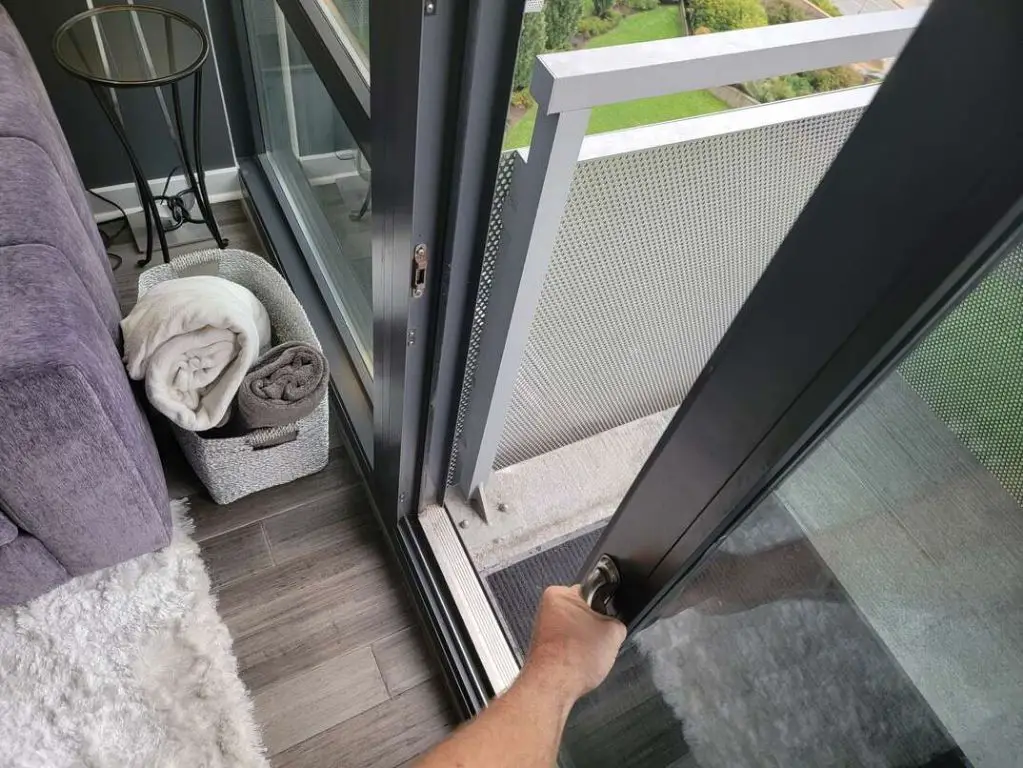Over time, sliding glass doors can become difficult to open and close. A sliding door that doesn’t glide smoothly can be frustrating and require a lot of effort to operate. Thankfully, there are several quick and easy solutions to make a stubborn sliding glass door slide more easily again.
Page Contents
What causes sliding doors to stick?
There are a few common reasons why sliding glass doors become hard to operate:
– Dirt and debris – Dust, dirt, leaves, sand, and other debris can accumulate in the door track. This creates friction that prevents the door from sliding smoothly.
– Misalignment – If the door is sagging or unlevel, it can rub against the frame making it harder to open and close.
– Old rollers and wheels – The rollers/wheels on the bottom of the door can become worn out or damaged over time. This affects how easily they roll.
– Paint buildup – Over time, layers of paint can cause the door track and rollers to stick.
– Weather conditions – Moisture, humidity, and temperature changes can cause wood doors and frames to swell, stick, and warp.
How to make a sliding glass door slide more easily
Here are 8 simple tips to get your sliding door gliding smoothly again:
1. Clean the track
– Use a vacuum cleaner attachment or broom to clean out any debris in the bottom track.
– Spray the track with a degreaser and scrub with a stiff brush to remove built-up dirt and grime.
– Wipe the track completely dry.
2. Adjust the rollers
– Check that all rollers/wheels are touching the track evenly.
– Tighten any loose screws to raise sagging rollers.
– Add plastic shims if necessary to level uneven rollers.
3. Lubricate the track and rollers
– Apply a silicone spray lubricant to the track and rollers. Avoid oil-based lubes which can collect debris.
– Open and close the door a few times to distribute the lubricant.
– Re-apply every 6 months.
4. Check for alignment issues
– Inspect the door frame and surrounding walls for any sagging or gaps.
– Use shims between the frame and rough opening to realign the door if needed.
– Adjust the track height as required.
5. Replace damaged rollers
– Examine rollers for excessive wear or cracks.
– Replace any damaged rollers with new ones.
– Use the manufacturer’s replacement parts for proper fit.
6. Smooth sticking paint layers
– Use sandpaper or steel wool to lightly smooth paint buildup on track.
– Carefully scrape paint from rollers so they turn freely.
– Repaint bare metal to prevent rust.
7. Adjust sliding door panels
– Make sure the sliding panel is level and centered in the frame.
– Adjust the gap between the panels if rubbing occurs.
– Realign adjustable height rollers.
8. Weatherproof the door
– Apply weatherstripping around the frame to seal air gaps.
– Install storm doors or panels to protect from the elements.
– Maintain finishes to prevent moisture damage.
Tips for ongoing sliding door care
Once you get your sliding glass door operating smoothly again, be sure to keep up with regular maintenance:
– Wipe debris from the track regularly before it builds up.
– Re-lubricate the track and rollers every 6-12 months.
– Listen for grinding sounds and address issues immediately.
– Keep seals and weatherstripping in good condition.
– Avoid slamming the door which can knock it out of alignment.
– Inspect rollers periodically and replace if worn.
When to call a professional
For major sliding door issues, it may be time to call a professional:
– The door is completely stuck and won’t budge.
– The glass is damaged or cracked.
– The door is very difficult to move even after basic maintenance.
– The frame is visibly warped, sagging, or damaged.
– You’ve adjusted everything but the door still won’t operate smoothly.
A skilled technician has specialized tools and expertise to accurately diagnose and fix stubborn sliding door problems. They can determine if the door track needs replacement or if structural issues with the framing are making the door bind.
Sliding door replacement
If your sliding glass door is too far gone, a full replacement may be needed:
| Pros | Cons |
|---|---|
|
|
When shopping for a replacement, look for sliding doors with premium rollers and durable frames that will stand the test of time. Investing in a high-quality door is worthwhile to prevent future operational problems.
Conclusion
Don’t put up with a stubborn sliding glass door that takes all your might to open. With some basic DIY troubleshooting and maintenance, you can get your door sliding like new again. Cleaning, lubricating, and adjusting the components are easy affordable fixes in most cases. But if your door is still a struggle after trying these solutions, call in a professional service for repairs. And if the door is beyond fixing, a replacement sliding door install can provide a smooth-gliding worry-free access point. Invest a little time and effort into reviving your sliding door and you’ll be rewarded with easy and convenient passage in and out of your home.
